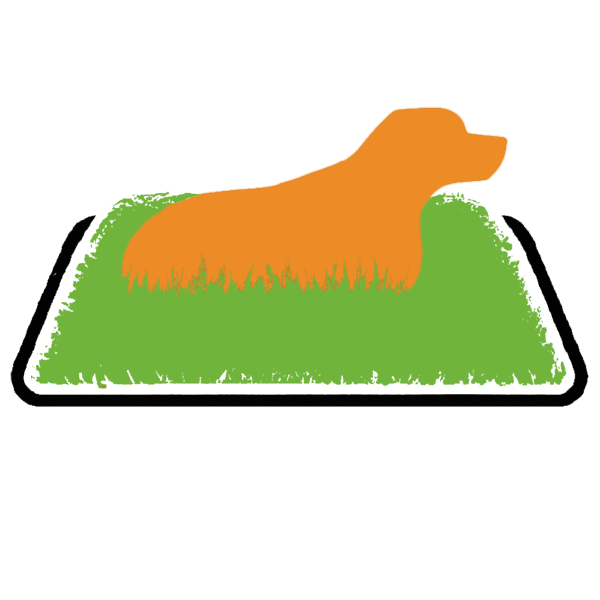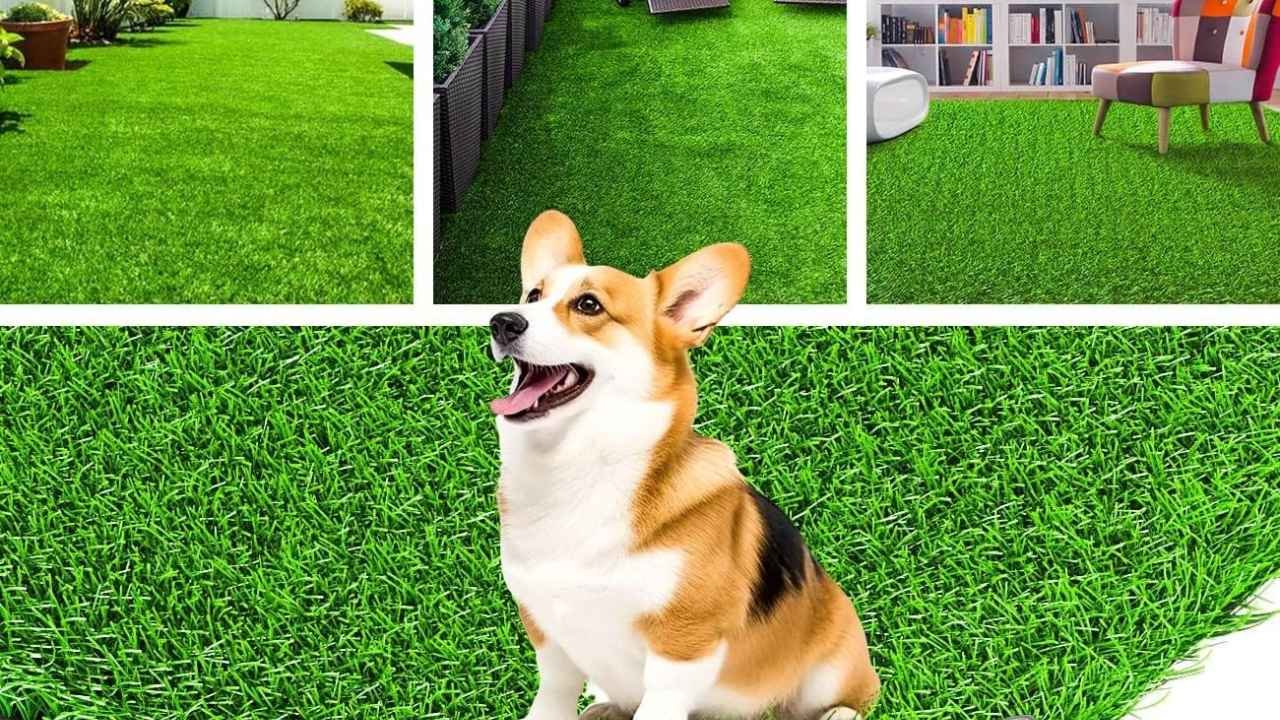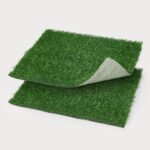As a responsible dog owner, proper potty training for your furry companion is essential to maintain a clean and hygienic environment. One innovative solution gaining popularity among pet owners is using grass pee pads for dogs. These pads offer a convenient and natural way to simulate outdoor potty experiences indoors, making them an excellent option for those living in apartments, high-rises, or areas with limited outdoor access.
Grass pee pads for dogs are specially designed mats or patches that replicate the look and feel of natural grass. These pads come in various sizes and are made with synthetic or natural grass, providing a comfortable and familiar surface for dogs to do their business.
Using dog grass pee pads offers numerous benefits to owners. First and foremost, they provide a designated potty area within the confines of your home, reducing the need for frequent trips outdoors, especially during inclement weather. They are also an excellent solution for senior dogs or puppies still in the process of being fully vaccinated and unable to venture outside.
While dog grass pee pads offer a convenient option for indoor potty training, it is essential to remember that successful usage depends on proper training. Introducing your furry friend to using a grass pee pad requires patience, consistency, and positive reinforcement to establish a healthy potty routine.
What Are Dog Grass Pee Pads?
- What grass pee pads are, and how do they differ from traditional pads?
Grass pee pads differ significantly from traditional ones, usually made of absorbent materials like paper or polymer. The unique feature of grass pee pads lies in their surface, which mimics the texture of natural grass, making them more appealing to dogs and encouraging natural potty behavior.
- The different types of grass pee pads available in the market
In today’s market, a wide variety of dog grass pee pads exist. Some dog grass pads use natural grass, while others use high-quality synthetic grass that is non-toxic and easy to clean. The options range from small, disposable pee pads ideal for puppies to more extensive, reusable pads suitable for larger breeds.
Type of Grass Pee Pad | Features | Pros | Cons |
Natural Grass Pee Pad | – Mimics the texture and scent of real grass. – Biodegradable and environmentally friendly. | – Appeals to a dog’s natural instincts, making it easier for them to use. – Eco-friendly option. | – Requires regular replacement as natural grass can degrade quickly. – More expensive than synthetic grass pads. |
Synthetic Grass Pee Pad | – Non-toxic and easy to clean. – Durable and long-lasting. | – Easy maintenance; can be rinsed or hosed down. – Cost-effective option in the long run. | – Some dogs may take time to adjust to the texture and scent. – May not fully replicate the experience of real grass. |
- The advantages of using grass pee pads for dogs
One significant advantage of using grass pee pads is that they help prevent the development of undesirable potty habits. Dogs naturally seek out grassy areas to relieve themselves, so having a designated Indoor grass for dogs reinforces their instincts and prevents them from associating indoor spaces with potty areas.
Using grass pee pads can also be valuable during indoor to outdoor potty training. Dogs can become accustomed to the grassy surface, making it easier to adapt to outdoor environments when the time comes.

Preparing for Training
- Selecting the right location for the grass pee pad
Choosing the appropriate location for your grass pee pad is crucial for successful training. Ideally, select an easily accessible area of your home, preferably near an exit or easily cleanable surface. This ensures that your dog can quickly reach the designated spot when needed.
- Introducing the grass pee pad to your dog
Before training begins, allow your dog to familiarize themselves with the grass pee pad. Place it in the selected location and let them investigate and sniff around. This helps establish a positive association with the pad and lets your dog become comfortable with its presence.
- Gathering necessary training supplies
To ensure smooth training, gather all the necessary supplies. This may include the grass pee pad itself, cleaning supplies, treats for rewards, and a leash for guiding your dog to the designated area. Having everything readily available will help streamline the training process.
Step-by-Step Training Guide
- Establish a consistent feeding and potty schedule
Consistency is critical in training your dog to use the grass pee pad. Establish a regular feeding schedule to help regulate your dog’s potty needs. By feeding consistently, you can anticipate when your dog will likely need to relieve themselves, making it easier to guide them to the grass pee pad.
2. Identifying signs that your dog needs to go potty
Pay close attention to your dog’s behavior and look for signs they may need to go potty. Common symptoms include restlessness, sniffing around, circling, or sudden changes in activity level. Recognizing these cues lets you promptly guide your dog to the grass pee pad.
3. Using positive reinforcement techniques for training
Positive reinforcement is crucial in training your dog to use the grass pee pad. Whenever your dog successfully uses the pad, praise them enthusiastically and offer treats as rewards. This positive association will encourage them to repeat the desired behavior and reinforce their understanding of the purpose of the grass pee pad.
4. Take your dog to the grass pee pad at regular intervals
Regularly take your dog to the grass pee pad throughout the day to establish a routine. This includes after meals, naps, playtime, and waking up in the morning or after a nap. Consistency will help your dog develop a reliable potty routine and minimize accidents.
5. Encouraging your dog to use the grass pee pad
When guiding your dog to the grass pee pad, use verbal cues or commands to reinforce the desired behavior. For example, consistently use phrases like “Go potty” or “Potty time” when you bring them to the pad. Over time, your dog will associate these commands with using the grass pee pad.
6. Dealing with accidents and how to handle them
Accidents are a normal part of the training process. If your dog has an accident outside the grass pee pad, do not punish or scold them. Instead, calmly clean up the mess and continue with the training. Punishment can create anxiety and hinder training progress. Focus on reinforcing positive behavior and redirecting your dog to the grass pee pad.
7. Gradually extend the time between potty breaks
As your dog becomes more accustomed to using the grass pee pad, you can gradually extend the time between potty breaks. This helps build their bladder control and reinforces the concept of using the designated area for potty needs. Monitor your dog’s behavior and gradually increase the intervals based on their progress.
Following this step-by-step training guide pave the way for successful indoor grass training pads for dogs. Stay consistent, patient, and positive throughout the process, and soon your dog will be confidently using the designated grass pee pad as their preferred potty spot.
This is the video of how to potty train your puppy to “Go Potty” on the portable dog lawn:
Troubleshooting Common Challenges
- Lack of interest in the grass pee pad
If your dog shows little interest in the grass pee pad, don’t worry; this is a common challenge during puppy training grass pads. Place some of their favorite toys or treats near the pad to spark curiosity. Spending time together in the designated potty area can encourage them to associate it with positive experiences.
- Frequent accidents outside the pad
Accidents outside the grass pee pad can happen, especially during the initial stages of training. Review your dog’s feeding and potty schedule to ensure it meets their needs. If accidents occur, remain patient and reinforce positive behavior when they do use the pad. Avoid scolding or punishing them, as this can create anxiety and disrupt the training progress.
- Fear or hesitation in using the grass pee pad
Some dogs may fear or hesitate about the grass pee pad, mainly if they are not used to its texture or smell. To alleviate their concerns, spend time together near the pad, offering reassurance and praise. Gently guide them onto the pad using treats and positive reinforcement. Over time, their fear should subside as they become more accustomed to the grass’s surface.
Maintaining the Habit
- Cleaning and maintaining the grass pee pad
Proper maintenance of the grass pee pad is essential to ensure your dog’s continued use and to prevent odors or bacterial growth. Regularly remove any solid waste and hose down the dog grass pads to avoid unpleasant smells. Synthetic dog grass pads should be cleaned with pet-friendly disinfectants and deodorizers. Replace disposable pads as needed to maintain a clean and hygienic environment for your pet.
- Tips for consistency in the training process
Consistency is critical to successful indoor potty training. Stick to the established feeding and potty schedule, ensuring your dog can regularly use the grass pee pad. Use positive reinforcement, verbal cues, and rewards for successful potty behavior. Be patient and avoid sudden changes to the training routine, as this can confuse your dog and hinder progress.
- Reinforcing the habit during the transition to outdoor potty
If your dog becomes proficient in using the grass pee pad, you may consider transitioning them to outdoor potty training. When introducing outdoor potty breaks, maintain the same verbal cues and positive reinforcement used during indoor training. Gradually reduce the frequency of indoor potty breaks and extend the time spent outdoors. Monitor your dog’s progress and offer praise and rewards during successful outdoor potty sessions.
Additional Tips and Considerations
- Keeping the grass pee pad area appealing to your dog
Keep the site clean and appealing to maintain your dog’s interest in using the grass pee pad. Regularly remove waste and ensure the pad is well-maintained. Avoid placing the pad near their sleeping or eating areas; dogs prefer separate spaces for different activities.
- Avoiding punishment-based training methods
Positive reinforcement is the most effective and humane way to train your dog to use the grass pee pad. Avoid scolding or punishment for accidents, as this can create fear and anxiety, hindering the training progress. Instead, praise and reward their successes to foster a positive learning experience.
- Being patient and understanding throughout the training
Remember that each dog is unique, and training progress may vary. Be patient and understanding, especially during challenging moments. Celebrate small successes, and avoid comparing your dog’s progress to others. Your dog will gradually develop the desired potty habits with time and consistency.

Conclusion
Training your dog to use grass pee pads offers numerous benefits for you and your canine companion. From the convenience of indoor potty options to fostering a cleaner living environment, grass pee pads are valuable in your pet care toolkit.
Remember that success requires dedication and a positive attitude throughout the training process. Embrace the journey with your dog, cherishing the moments of progress and learning together. As you guide your furry friend toward a reliable indoor potty routine, you’ll witness strengthening of your bond and the development of a well-mannered, happy, and confident dog.
So, if you’re considering indoor potty training, take the plunge and start the training process with your dog. Be consistent, patient, and gentle, and always prioritize positive reinforcement. The time and effort invested will lead to a well-trained dog that confidently uses the grass pee pad, making your lives more comfortable and enjoyable.
Ultimately, the satisfaction of successfully training your dog and creating a harmonious living space will make every step of the journey worthwhile. Embrace this opportunity to enhance your relationship with your furry companion and make indoor potty training a positive and rewarding experience for all. Happy training!



